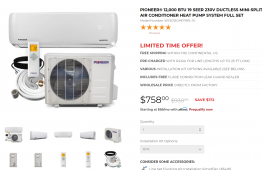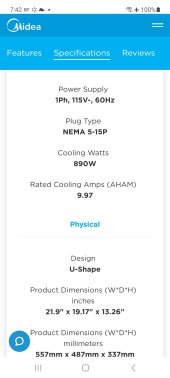You are using an out of date browser. It may not display this or other websites correctly.
You should upgrade or use an alternative browser.
You should upgrade or use an alternative browser.
HOW MANY WATTS DOES YOUR DUCTLESS MINI-SPLIT AC USE
- Thread starter ice2484
- Start date
D
Deleted member 4428
Guest

Solar And Mini Splits
I need to heat and dehumidify my basement. My Service Panel at this point is full. Am I crazy to think I can heat and etc less than 1000 sqft using solar and mini splits? I have seen videos on youtube were guys are heating and cooling their RVs as well as small homes using a DC only mini...

14 SEER or 20 SEER: What’s the Difference?
Why consider a higher SEER rating on an AC unit? If comfort is one of the main concerns with your current system, a higher SEER rating would be preferable because the higher SEER means more comfort.
www.annisonbitter.com
Mart Hale
New Member
- Joined
- Feb 4, 2020
- Messages
- 180
I have 2 mini splits, I have the Midea U which the owner of this board just did a video about, it is 15 seer, 10,000 btu, however the most it pulls is 450 watts, thus I can use a standard solar system to power it. The big advantage it has is it is portable, at any time I can move it anywhere, the other 240 V mini split I installed from Serville is forced to stay put, has a seer over 20, and can heat as well as cool. Because the Midea U works so well for me I have been running it here in Florida cooling 3 rooms and it works good enough to be 10 deg cooler than outside, it will use less energy when the room cools off so it does not destroy my batteries energy. Another option is the DC mini splits out there that normally are 48V they cost like an extra thousand more, but the seer rating is far higher. Having the ability to run my Midea off generator and solar is the big selling point for me.
Mart Hale
New Member
- Joined
- Feb 4, 2020
- Messages
- 180
I installed a Mr. Cool mini split, if you have the option if you go this route pull a vacuum on the lines before you release the refrigerant. We did not do this and we had a bad fitting and had to pay an AC tech to come out pull the refrig out of the lines, and replace the bad fitting, not cheap, but it works like a champ now.
Joe BoyKey
Watts, Watts, more Watts
Zwy
Solar Wizard
I'm waiting to see how this works for one member. https://diysolarforum.com/threads/i...ts-in-tech-news-or-anything.21064/post-253431I am thinking about getting a ductless mini-split ac but was wonder how many watts of power they use.
I have been looking at 12000 BTU and 18000 BTU 19 to 22 seer.
Has anybody checked power consumption of there unit?
LittleLebowski
Solar Enthusiast
- Joined
- Mar 20, 2022
- Messages
- 165
I know this is an older post, but 450w draw from the Midea might meet my needs, I can’t find the video Will did about this unit, and I’m looking for more real world experience on these.I have 2 mini splits, I have the Midea U which the owner of this board just did a video about, it is 15 seer, 10,000 btu, however the most it pulls is 450 watts, thus I can use a standard solar system to power it. The big advantage it has is it is portable, at any time I can move it anywhere, the other 240 V mini split I installed from Serville is forced to stay put, has a seer over 20, and can heat as well as cool. Because the Midea U works so well for me I have been running it here in Florida cooling 3 rooms and it works good enough to be 10 deg cooler than outside, it will use less energy when the room cools off so it does not destroy my batteries energy. Another option is the DC mini splits out there that normally are 48V they cost like an extra thousand more, but the seer rating is far higher. Having the ability to run my Midea off generator and solar is the big selling point for me.
littleharbor2
Solar Addict
Surprised there's no mention of inverter based Mini Split units. Is there no negligible difference in efficiency or power consumption between inverter and non inverter based units?
LeoThomson
Solar Addict
- Joined
- Jun 20, 2022
- Messages
- 3,469
The Midea U is a window air conditioner, they are very good units but designed for sash windows. They can be used in other types of windows, but you will need to make something to seal the window opening. Which is fairly easy to do...I know this is an older post, but 450w draw from the Midea might meet my needs, I can’t find the video Will did about this unit, and I’m looking for more real world experience on these.
Run them in eco mode, uses far less power.
Last edited:
Plum Crazy Rob
Solar Enthusiast
RCinFLA
Solar Wizard
- Joined
- Jun 21, 2020
- Messages
- 3,565
Air conditioners using R410A or R32 refrigerant run about 800-900 watts of electric power per 12,000 btu's (one ton) of heat transfer.
Mini-splits improve their average power consumption by reducing compressor and fan speed when full cooling capacity is not required. A typical application requires near 100% capacity when first turned on with high temperature and high indoor humidity. It takes a lot of btu's to convert water vapor humidity to liquid water condensate. This btu consumption drops off as room humidity and temperature drops. Once room temp and humidity is brought down the required btu's to maintain temp and humidity drops significantly to 25% or 30% of full air conditioner btu capacity.
Mini-splits are usually less efficient at full capacity rating compared to a conventional split ducted system. They have electrical loss in the three phase variable speed inverter power electronics that drives the three-phase compressor motor.
Reducing head pressure on compressor output reduces the amount of work required by compressor and the amount of electric power needed. A good way to do this is with larger outside condenser heat exchanger. Mini-splits are often built with smaller condenser heat exchanger.
Having the ability to control the speed of compressor and tight control on expansion valve via stepper motor adjustment allows running a lower refrigerant charge amount and less input to output pressure differential on compressor, requiring less work by compressor.
Another way to improve air conditioner efficiency is to reduce the required superheat and subcooling margin on refrigerant charge.
Subcooling is the average refrigerant pressure and corresponding average temperature of refrigerant in condenser heat exchanger to temperature of liquid refrigerant leaving condenser.
Superheat is the refrigerant pressure and corresponding average temperature of refrigerant gas in the cooling evaporator to the temperature of refrigerant gas returning to the suction input of compressor. The returning refrigerant gas must still be cool enough to provide compressor internal cooling so a minimum superheat must be maintained. A minimum subcooling on liquid line refrigerant is necessary to ensure a constant liquid refrigerant flow to expansion valve.
Mini-splits improve their average power consumption by reducing compressor and fan speed when full cooling capacity is not required. A typical application requires near 100% capacity when first turned on with high temperature and high indoor humidity. It takes a lot of btu's to convert water vapor humidity to liquid water condensate. This btu consumption drops off as room humidity and temperature drops. Once room temp and humidity is brought down the required btu's to maintain temp and humidity drops significantly to 25% or 30% of full air conditioner btu capacity.
Mini-splits are usually less efficient at full capacity rating compared to a conventional split ducted system. They have electrical loss in the three phase variable speed inverter power electronics that drives the three-phase compressor motor.
Reducing head pressure on compressor output reduces the amount of work required by compressor and the amount of electric power needed. A good way to do this is with larger outside condenser heat exchanger. Mini-splits are often built with smaller condenser heat exchanger.
Having the ability to control the speed of compressor and tight control on expansion valve via stepper motor adjustment allows running a lower refrigerant charge amount and less input to output pressure differential on compressor, requiring less work by compressor.
Another way to improve air conditioner efficiency is to reduce the required superheat and subcooling margin on refrigerant charge.
Subcooling is the average refrigerant pressure and corresponding average temperature of refrigerant in condenser heat exchanger to temperature of liquid refrigerant leaving condenser.
Superheat is the refrigerant pressure and corresponding average temperature of refrigerant gas in the cooling evaporator to the temperature of refrigerant gas returning to the suction input of compressor. The returning refrigerant gas must still be cool enough to provide compressor internal cooling so a minimum superheat must be maintained. A minimum subcooling on liquid line refrigerant is necessary to ensure a constant liquid refrigerant flow to expansion valve.
Mart Hale
New Member
- Joined
- Feb 4, 2020
- Messages
- 180
The amount of watts pulled depends on if you have it set on full blast or not...... Hotter days more power required. The most watts I find it pulls is when in dehumidify mode. I am very pleased with it as it is portable, and quiet and so much easier to install than a mini split, but it does not heat which may kill the deal for some.
RCinFLA
Solar Wizard
- Joined
- Jun 21, 2020
- Messages
- 3,565
Dehumidify mode just slows the indoor fan down to allow more time for air to be in contact with cooling evaporator coil. It allows more humidity to condense out on evaporator coils, but it reduces the air real heat extraction.
Many commercial buildings have oversized air conditioners to allow for maximum 'body count' occupancy. When not loaded with people they quickly cool air and shut off quickly. This leaves air with high humidity and the building feeling like a cool, damp, cave.
Many commercial buildings have oversized air conditioners to allow for maximum 'body count' occupancy. When not loaded with people they quickly cool air and shut off quickly. This leaves air with high humidity and the building feeling like a cool, damp, cave.
Last edited:
LittleLebowski
Solar Enthusiast
- Joined
- Mar 20, 2022
- Messages
- 165
Any idea on very rough, seat of pants averages on watts pulled in regular and eco modes?The amount of watts pulled depends on if you have it set on full blast or not...... Hotter days more power required. The most watts I find it pulls is when in dehumidify mode. I am very pleased with it as it is portable, and quiet and so much easier to install than a mini split, but it does not heat which may kill the deal for some.
I would be looking at minisplits, but I should be selling this house either this summer or next spring, and don't want to do any more permanent work. I'm hoping this Midea can run mostly off of PV during the day, I'd be using my Ecoflow Delta setup (two Delta pros and three spare batteries).
Mart Hale
New Member
- Joined
- Feb 4, 2020
- Messages
- 180
Actually I don't. I run these full blast when he sun is shining to use the max amount of watts the solar panels produce About 5,000 watts of solar. I keep an eye on the battery, and I also use the timer function on the AC and set it for like 5 hours. After the AC shuts off I go look at how much of the day is left, and see how much is in the battery and then I run the amount that gives me reserve capacity to get me thru to the next day. This gives me flexibility for cloudy days. I have generator backup for cloudy days, but I have not had to use it but like 2 times a year.
Similar threads
- Replies
- 23
- Views
- 891
- Replies
- 22
- Views
- 1K
- Replies
- 0
- Views
- 274




